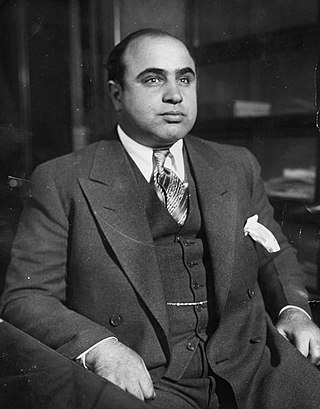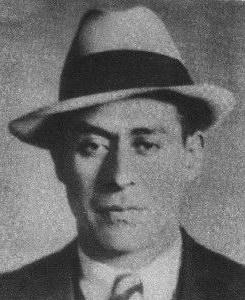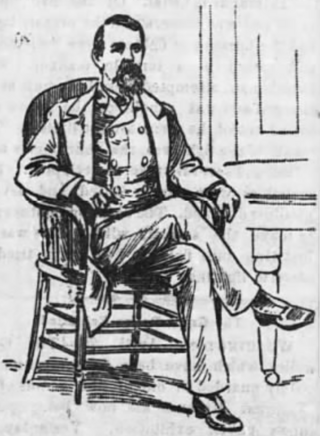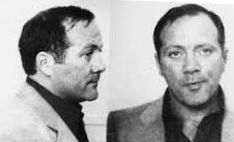
Alphonse Gabriel Capone, sometimes known by the nickname "Scarface", was an American gangster and businessman who attained notoriety during the Prohibition era as the co-founder and boss of the Chicago Outfit from 1925 to 1931. His seven-year reign as a crime boss ended when he went to prison at the age of 33.

Vincent Drucci, also known as "The Schemer", was an American mobster during Chicago's Prohibition era who was a member of the North Side Gang, Al Capone's best known rivals. A friend of Dean O'Banion, Drucci succeeded him by becoming co-leader. He is the only American organized crime boss to have been killed by a policeman.

The Chicago Outfit is an Italian-American organized crime syndicate or crime family based in Chicago, Illinois, which originated in the city's South Side in 1910. It is part of the larger Italian-American Mafia.
Leonard Arthur McPherson was one of the most notorious and powerful Australian career criminals of the late 20th century. McPherson is believed to have controlled most of Sydney's organised crime activity for several decades, alongside his contemporary Abe Saffron and associate, bookmaker George Freeman.
The Irish Mob is a usually crime family–based ethnic collective of organized crime syndicates composed of primarily ethnic Irish members which operate primarily in Ireland, the United States, the United Kingdom, Canada and Australia, and have been in existence since the early 19th century. Originating in Irish-American street gangs – famously first depicted in Herbert Asbury's 1927 book, The Gangs of New York – the Irish Mob has appeared in most major U.S. and Canadian cities, especially in the Northeast and the urban industrial Midwest, including Boston, New York City, Philadelphia, Pittsburgh, Baltimore, Cleveland, and Chicago.

Roger Touhy was an Irish American mob boss and prohibition-era bootlegger from Chicago, Illinois, in the United States. He is best remembered for having been framed by his rivals in Chicago organized crime for the fake 1933 kidnapping of Jewish-American organized crime figure and Chicago Outfit associate John "Jake the Barber" Factor, a brother of cosmetics manufacturer Max Factor Sr.. Despite numerous appeals and at least one Federal court ruling freeing him, Touhy spent 26 years in prison until he was finally exonerated and released in November 1959. In retaliation for filing a lawsuit against acting boss Tony Accardo and other senior Mafiosi, Touhy was murdered in an alleged contract killing by the Chicago Outfit less than a month after his release.
The North Side Gang, also known as the North Side Mob, was an Irish-American criminal organization within Chicago during the Prohibition era from the early 1920s to the mid-1930s. It was the principal rival of the South Side Gang, also known as the Chicago Outfit, the crime syndicate of Italian-Americans Johnny Torrio and Al Capone.

Louis "Little New York" Campagna was an American gangster and mobster and a high-ranking member of the Chicago Outfit for over three decades.

Big Boy is a fictional gangster in the comic strip Dick Tracy, created by Chester Gould, and was the first featured in a long line of colorful Dick Tracy villains. The character was featured in the 1990 film, paired with Breathless Mahoney.
Egan's Rats was an American organized crime gang that exercised considerable power in St. Louis, Missouri, from 1890 to 1924. Its 35 years of criminal activity included bootlegging, labor slugging, voter intimidation, armed robbery, and murder. Although predominantly Irish-American, Egan's Rats did include a few Italian-Americans and some Jewish immigrants, most notably Max "Big Maxie" Greenberg.

Franklin Rio also known as "Frank Rio" and "Frank Cline" was a member of Al Capone's Chicago-based criminal organization known as the Chicago Outfit. He was also an alleged gunman in the famous 1929 St. Valentine's Day Massacre.
William Jackson, also known as Action Jackson was an enforcer and loan collector for the Chicago Outfit. He earned his nickname of "Action" because it was slang for "Juice Man", which meant debt-collector. He was tortured to death by his fellow gangsters, allegedly on suspicion that he had become an informant for the FBI.
Pat Desmond was a lawman and gunman of the American Old West. He was listed as one of the twelve most underestimated gunmen of the Old West in the book "Deadly Dozen", written by Robert K. DeArment.

Francis Crowley was an American murderer. His crime spree lasted nearly three months, ending in a two-hour shootout with the New York City Police Department on May 7, 1931, that was witnessed by 15,000 bystanders and received national attention. In 1932 he was executed in New York's electric chair.

The Purple Gang, also known as the Sugar House Gang, was a criminal mob of bootleggers and hijackers composed predominantly of Jewish gangsters. They operated in Detroit, Michigan, during the 1920s of the Prohibition era and came to be Detroit's dominant criminal gang. Excessive violence and infighting caused the gang to destroy itself in the 1930s.
The College Kidnappers was a group of alumni from the University of Illinois who specialized in kidnapping wealthy mobsters for ransom. These mobsters were targets because they were less likely to approach the police and could pay the ransom.

The Barker–Karpis Gang was one of the longest-lived criminal gangs during the Depression Era, spanning from 1931 to 1935. The gang was founded by Fred Barker and Alvin Karpis, and later joined by Fred's brother Arthur "Doc" Barker. Along with the three core members, the gang's network spanned up to 25 members at one point.
Ellen Scanlon, born Ellen Hanley, was an Irish murder victim. Born to a Limerick farming family in 1803, her murder at age 15 became the subject of books, plays, films, songs, and an opera, using the nickname given to her locally, "the Colleen Bawn,", which translates literally to "white girl," with "white" symbolically meaning purity, innocence, gentleness, or beauty. Thus the name can be interpreted as "the innocent maiden."

Michael Cassius McDonald was a crime boss, political boss, and businessman based out of Chicago. He is considered to have introduced organized crime to the city, and to have also established its first political machine. At the height of his power, he had influence over politicians of all levels in the state of Illinois.

Allan Ronald Ross, better known as "Allan the Weasel", was a Canadian gangster best known for leading the West End Gang of Montreal. At the time of his arrest in Florida in 1991, he was described by American law enforcement as the fifth most important drug kingpin in the world.













